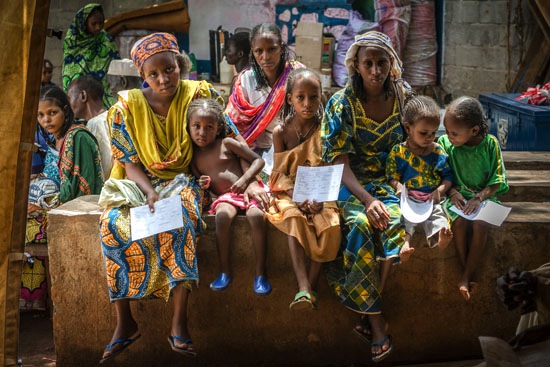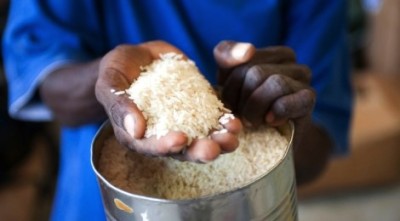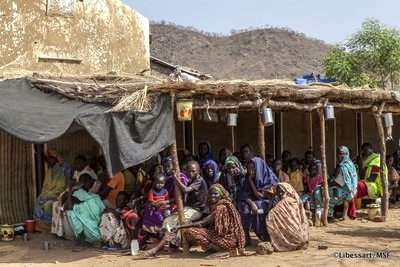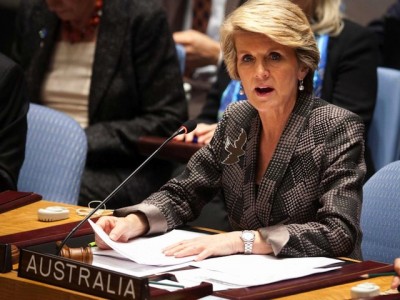
Muslims in Carnot in Peul. Nomadic pastoralists have lost their livestock. Photo: Yann Libessart/MSF.
In the wake of Julie Bishop’s ‘new aid paradigm’ announcement, and as we reach the end of the ‘age of entitlement’ and prepare for some heavy lifting, Ruth Cooper investigates the Abbott government’s approach to foreign aid.
From revolting students to pensioners turned sex line workers, it seems everyone has an opinion on the Coalition’s recent budget. But, as the debate focuses on $7 doctors visits and “earning or learning”, an entire group of people have been largely forgotten – the millions who benefit from Australian foreign aid. Foreign Minister Julie Bishop addressed this during an appearance at the National Press Club, Canberra on July 18, where she outlined the Coalition’s “new aid paradigm” and the six core priority areas for Australian aid.
In his budget night speech, between talk of the “debt and deficit disaster” created by the former Labor government, Treasurer Joe Hockey succinctly addressed the question of foreign aid. “The government,” Mr Hockey proclaimed, “has decided to reduce the growth in our foreign aid budget to save $7.6 billion over five years.”
According to the Budget Measures paper, this saving will be achieved in part by keeping official development assistance (ODA) at the 2013-14 level of $5 billion during 2014-15 and 2015-16. From 2016-17, the ODA will then grown in line with the Consumer Price Index. As Stephen Howes, Director of the Development Policy Centre (DPC) at the Australian National University wrote on the DPC blog, this means “aid in 2016-17 would be at 2012-13 levels after adjusting for inflation”.
While the government obviously thinks this is a necessary cut, some, including Mr Howes, see the figures as disproportionate. In fact, as World Vision Australia chief executive Tim Costello pointed out recently, while aid spending makes up just 1.3 per cent of the total budget, aid cuts contribute 20 per cent of the savings.
In selling these figures, Minister for Foreign Affairs Julie Bishop has been eager to appeal to voters looking to get the most bang for their buck.
“Australian taxpayers can be reassured that their aid dollar is being used in the most efficient and effective way possible,” Ms Bishop said at a press conference in Adelaide on May 23. “I made a decision going into the last election that we needed to stabilise our foreign aid budget. It is now responsible, it is affordable [and] it is sustainable.”
This emphasis on affordability came through strongly during Ms Bishop’s Press Club speech. By introducing a “new aid paradigm”, the Coalition aims to achieve “better value-for-money” from aid programs, Ms Bishop said. As part of this, the government will be introducing a system of performance benchmarks, which will mean projects that don’t deliver the expected results will be “put on a rigorous path to improvement or be terminated”.
Ms Bishop also spoke about the need to align “the goal of poverty reduction with the pursuit of regional economic growth”, and said that the Coalition will be “aiming for aid recipient nations to transform into sustainable economies”.
She identified six core priority areas for Australian foreign aid including: infrastructure and trade; agriculture, fisheries and water management projects; a focus on effective governance; education and health; humanitarian assistance; and the empowerment of women and girls. Ms Bishop said the latter was a “personal passion”, and that one of the performance benchmarks the government is implementing is that all aid investments must assess gender issues with at least 80 per cent focused on the support and empowerment of women.
Ms Bishop also stressed the “unmistakeable regional focus” of the Coalition’s aid programme. “In the past, it’s been spread far too thinly across the globe,” said Ms Bishop, “thus putting at risk our ability to achieve results in the geographic region where I believe we have a primary responsibility, the Indian Ocean Asia Pacific. We must direct our aid to where we can make the biggest difference and align it with our national interest.”
 Prior to Ms Bishop’s announcement, Shadow Foreign Minister Tanya Plibersek had been speaking out about the real-world impact of the aid budget. In an interview with Sky News on May 28, Ms Plibersek passionately denounced the planned cuts. “If you had two $50 notes and someone told you that 50 cents would save a life, would you give them that 50 cents?” asked Ms Plibersek. “Our foreign minister says no.” The Shadow Minister has also been vocal about Labor’s past aid achievements. “In the Solomon Islands and Vanuatu, we have dropped the malaria rate by 50 and 80 per cent,” she said. “Our aid budget is making a huge difference to the lives of the world’s poorest people.”
Prior to Ms Bishop’s announcement, Shadow Foreign Minister Tanya Plibersek had been speaking out about the real-world impact of the aid budget. In an interview with Sky News on May 28, Ms Plibersek passionately denounced the planned cuts. “If you had two $50 notes and someone told you that 50 cents would save a life, would you give them that 50 cents?” asked Ms Plibersek. “Our foreign minister says no.” The Shadow Minister has also been vocal about Labor’s past aid achievements. “In the Solomon Islands and Vanuatu, we have dropped the malaria rate by 50 and 80 per cent,” she said. “Our aid budget is making a huge difference to the lives of the world’s poorest people.”
While there has been a positive reaction to Ms Bishop’s announcement from many in the aid community, particularly about the Coalition’s focus on women and girls, and their aim to implement innovative practices, in a June 18 statement, Ms Plibersek said that “the Abbott Government is wrong if it thinks its ‘fresh new approach’ to aid can explain away its devastating $7.6 billion cut in aid to the world’s poor. The aid program doesn’t need cosmetic makeovers, it needs appropriate levels of funding and experienced delivery.”
“Julie Bishop must explain to the world’s poorest nations how her ‘fresh new approach’ will make all the difference while she rips billions from the budget that supports things like food programs, childhood immunisation, maternal health, and treatment for HIV and malaria.”
Aside from the moral and ethical reasons to give aid, Ms Plibersek has also been focused on the strategic imperatives. “Australia’s aid and development program is in our national interest,” said Ms Plibersek in a May 4 statement. “It enhances our international influence, helps to prevent conflict and terrorism and builds relationships.”
 Professor Geoff Gallop, Director of the Graduate School of Government at Sydney University and a former politician, agrees. “It’s in Australia’s national interest to devote serious resources to international aid,” said Mr Gallop. “We can expand the opportunities of our own people either by becoming more competitive ourselves or by helping expand the world market. It’s limiting and short sighted to focus all efforts on the first of these strategies at the expense of the second. At its core is a ‘beggar thy neighbour’ way of thinking.”
Professor Geoff Gallop, Director of the Graduate School of Government at Sydney University and a former politician, agrees. “It’s in Australia’s national interest to devote serious resources to international aid,” said Mr Gallop. “We can expand the opportunities of our own people either by becoming more competitive ourselves or by helping expand the world market. It’s limiting and short sighted to focus all efforts on the first of these strategies at the expense of the second. At its core is a ‘beggar thy neighbour’ way of thinking.”
This is an understanding shared by Paul Kelly, Principal Executive of CARE Australia’s International Programs. “Poverty is closely correlated with instability and conflict,” said Mr Kelly, “and we’ve seen that it provides the space for people with extreme ideas to become influential.” As 18 out of 20 of Australia’s closest neighbours are low-income countries, it is important to be aware that “what happens in our region impacts on us”, making aid an effective way of promoting stability in neighbouring countries.
Although CARE Australia receives private donations, government funding also helps the organisation manage programs in 24 countries across the Asia-Pacific, Africa and the Middle East. According to Mr Kelly, the cuts to aid have been seen as “disappointing” by those involved in aid programs.
As Ms Bishop indicated, a large impact of the aid cuts will be a smaller geographic focus.
“The government has reinforced the prime focus on Australia’s geographic region…and that’s fair enough,” said Mr Kelly, “but Australia will need to respond to other global crises and we need to have an aid program that can do that.”
On a more personal level, Mr Kelly knows the cuts will have a big impact on what his organisation can achieve. “Earlier this year I was in Timor-Leste looking at a program CARE is implementing, funded by the Australian government, where we’re trying to work with around 3000 families to help them adapt to changing climate patterns,” said Mr Kelly. A main aim of this is helping locals grow enough food to eat. “We know that after this year, this program won’t continue.”
 The future of other programs, including an effort to help over 200,000 people in rural and remote areas of Afghanistan, is also tenuous. “Because of budget constraints the funding for these programs is probably going to be reduced,” said Mr Kelly. “We may end up having to halve the number of people we’re able to support in that particular program.”
The future of other programs, including an effort to help over 200,000 people in rural and remote areas of Afghanistan, is also tenuous. “Because of budget constraints the funding for these programs is probably going to be reduced,” said Mr Kelly. “We may end up having to halve the number of people we’re able to support in that particular program.”
Although Mr Kelly sees Australia as a good development partner, he said that, “in terms of the proportion of money we spend, we are probably in the middle of the pack when we compare with other aid donors”. This is surprising when you consider the ambition usually apparent in Australian foreign policy. “Often the government and officials like to talk about Australia punching above its weight,” said Mr Kelly. “Setting ourselves back in the middle of the pack like this doesn’t align with those kind of ambitions.”
In contrast, Britain, which was affected by the Global Financial Crisis more severely than Australia, has recently increased aid spending to 0.7 per cent of gross national income. By 2017, the proportion of aid to national income in Australia is expected to be below 0.3.
Looking to the future of Australian aid, Mr Kelly isn’t sure what to expect. “The trajectory that the government has now set for the aid program really does set the aid program back a decade,” said Mr Kelly. “We’re just waiting to see.”





